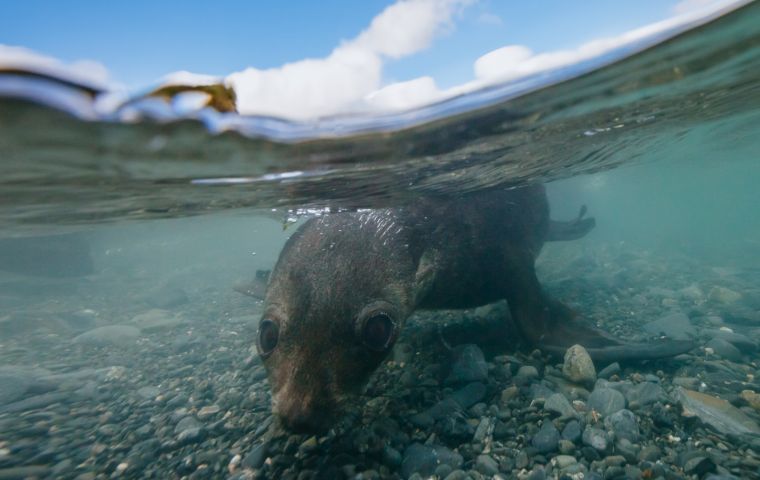MercoPress. South Atlantic News Agency
Falklands home to the largest population of South American fur seals
 The census, timed to coincide with the peak pupping season, focused on pups as an index for the population in general due to their distinctive black natal hair
The census, timed to coincide with the peak pupping season, focused on pups as an index for the population in general due to their distinctive black natal hair The Falkland Islands is home to the largest population of South American fur seals (Arctocephalus asutralis australis) in the world, according to a recent scientific paper.
The study, led by Dr Al Baylis and published in 2019, comes after an Island-wide census of the Falklands’ South American fur seal colonies carried out in January 2018.
The study calculated there to be some 36,425 South American fur seal pups across 10 breeding colonies in the Falklands.
The Jason Island group accounted for the overwhelming majority - 97% - of the fur seal pups counted during the survey. Within the Jason Island Group the largest colonies were: Jason West Cay, Seal Rocks, and Jason East Cay with 33%, 24.9% , 21.7% of the total pups counted in the Falklands respectively.
Colonies outside the Jason Island Group include Bird Island and Volunteer Rocks.
In addition to the ten breeding colonies, the survey identified five fur seal haul out sites; sites in which fur seals congregate but do not breed.
The survey used unmanned aerial vehicles, (UAVs) or drones, to take photographs of breeding colonies from a height of 30 meters. Between 100 and 550 pictures of each colony were taken, which were later stitched into a single ortho-mosaic photograph.
From this, a GIS shape file was created, enabling pups to be counted and geo-referenced.
The census, timed to coincide with the peak pupping season, focused on pups as an index for the population in general due to their distinctive black natal hair, or lanugo, making them easier to identify in photographs.
In addition, young pups of less than one month do not leave their natal colony. This is key, as the number of seals from a given colony that are at sea on the day of the count cannot be known.
Therefore pups provide a good stable indication of the size of the breeding colony as a whole. The results of the study provide key data on the population of the South American fur seal population in the Falklands.
The last census of fur seals in the Falklands was a partial census carried out in the 1980s. Prior to that, the last full island-wide census dated to as far back as 1965.
Thus the results of the 2018 census dramatically revised the previously available figures, resulting in a fourfold increase in the Falklands’ South American fur seal pup population.
The results are significant on a regional scale, too, and effectively double the species’ South Atlantic population. There are now thought to be 76,000 pups in the region, 48% of which are in the Falklands. However, the paper notes that the proportion could be higher due to uncertainty surrounding the Uruguayan population, which is estimated to account for 41%.
The paper concludes that, given its potential to disproportionately influence the global population status of the species, data on the Falklands population of South American fur seals is a key factor to be considered in conservation policies affecting the species.
The census cruise was directed by the crew of the FPV Protegat and FIG Fishery Protection Officer Christopher Peck. The census was supported by FIG and funds from the Winnifred Violet Trust, PADI Foundation, and a Waitt ROC grant. Equipment was loaned by Sulivan Shipping and Falklands Conservation, and additional UAV images were provided by S Crofts and A Stanworth. (Penguin News)




Top Comments
Disclaimer & comment rules-

-

-

Read all commentsPytangua: I think you mean “scroungers”, but your sentiment is incorrect. Perhaps you might explain what financial support the Falkland Islands gets from the British taxpayer. My explaining it to you would just be ignored, but it would interesting to see what you actually believe.
Feb 03rd, 2020 - 09:24 am +3Any overseas scrongers in the Falklands should be put on the very next flight back to where they came from - Argentina probably
Feb 03rd, 2020 - 11:50 am +2Falklands is also home to the laregst number of overseas scrongers off the British taxpayer.
Feb 03rd, 2020 - 08:43 am -2Commenting for this story is now closed.
If you have a Facebook account, become a fan and comment on our Facebook Page!